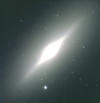|
Black holes were theorized more than 200 years ago, and later
were predicted by Einstein's theory of general relativity.
The discovery of active galaxies forced astronomers to think that
monstrous black holes really do exist and are the "engines" at the
heart of these fireworks. The gushers of light and other radiation
from such objects could not be explained by starlight alone.
By definition, a black hole is very hard to find. It is a celestial
object that squeezes a lot of material into a very small space. The
resulting gravitational pull is so intense that anything passing
nearby, even light, is trapped forever.
Like a ghost in a mystery story, a black hole's presence must be
inferred by the effects on its surroundings. Its powerful gravity
will influence the motion of neighboring stars. The closer the stars
are to the black hole, the faster they should be
moving, just as orbiting planets move faster the closer they are to
the Sun. If no black hole is present,
the speed of the stars should slow toward the hub of a galaxy,
because most of the gravity influencing their motion would come from
the other stars in the galaxy.
Once the speed of the entrapped material is measured, astronomers
can calculate the mass of the black hole using the
simple laws of gravity, just as the orbital speed of the Moon can be
used to calculate Earth's mass. If it turns out that there is far
more mass present than there are stars, the matter must be tucked
away in something that is invisible and compact.
Similar observations have been made with ground-based telescopes
since the mid-1980s; but having to look through the Earth's
turbulent atmosphere severely limits the accuracy of such telescopes
for detecting and measuring a large, central mass. While the
ground-based data give ambiguous lower limits to the central mass,
NASA Hubble Space Telescope observations are decisive
for accurately measuring the mass and ruling out all other possible
explanations.
 The
first black hole confirmation was nailed down when the space
telescope uncovered a spiral disk of gas swirling around the hub of
the giant elliptical galaxy M87 (called Virgo A,
located in the Constellation Virgo). The
first black hole confirmation was nailed down when the space
telescope uncovered a spiral disk of gas swirling around the hub of
the giant elliptical galaxy M87 (called Virgo A,
located in the Constellation Virgo).
 The
shape alone suggested that the material was caught in a
gravitational whirlpool. Using Hubble's spectrographs, astronomers
were able to measure the velocity of the gas by a method known as
Doppler shift. As the disk spins like a carousel, one side of it
approaches us and is blueshifted, while the other side rotates away
and is redshifted. The
shape alone suggested that the material was caught in a
gravitational whirlpool. Using Hubble's spectrographs, astronomers
were able to measure the velocity of the gas by a method known as
Doppler shift. As the disk spins like a carousel, one side of it
approaches us and is blueshifted, while the other side rotates away
and is redshifted.
 Astronomers
concluded that the gas is whirling at more than a million miles an
hour. This information can be used to calculate how much mass is
packed into the core of M87. It turns out that the
mass of two billion Suns is compressed into a region of space no
bigger than our solar system. Hubble has made similar observations
in two other elliptical galaxies, NGC 4261 and NGC 3115.
These monstrous black holes weigh in, respectively, at 200 million
solar masses and two billion solar masses. Astronomers
concluded that the gas is whirling at more than a million miles an
hour. This information can be used to calculate how much mass is
packed into the core of M87. It turns out that the
mass of two billion Suns is compressed into a region of space no
bigger than our solar system. Hubble has made similar observations
in two other elliptical galaxies, NGC 4261 and NGC 3115.
These monstrous black holes weigh in, respectively, at 200 million
solar masses and two billion solar masses.
|

The Giant
Elliptical Galaxy NGC 4261 |

NGC
4261:Trail of Black Holes and Neutron Stars Points to
Ancient Collision |

bright
lenticular galaxy, NGC 3115 |

NGC 3115 |
Surveys of galaxy nuclei
in both active and quiescent galaxies suggest black holes are
common
to virtually all galaxies. The mystery is how the black holes formed
in the first place. The abundance of quasars in the early universe,
objects at the hearts of galaxies that pour out a torrent of
radiation, suggest that monstrous black holes must have formed very
early, though it is still not known how this happened.
Hubble images of quasars show that they reside in a variety of
galaxies, both spiral and elliptical. Many but not all of the quasar
host galaxies, are engaged in a collision or interaction with other
bypassing galaxies. The infall of gas resulting from such collisions
fuels the monster black holes.
|